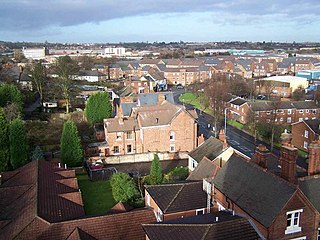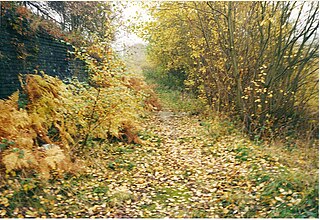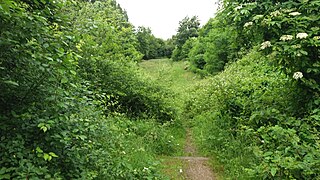
Tipton is an industrial town in the Metropolitan Borough of Sandwell in the West Midlands County in England. It had a population of 38,777 at the 2011 UK Census. It is located northwest of Birmingham and southeast of Wolverhampton. It is also contiguous with nearby towns of Darlaston, Dudley, Wednesbury and Bilston.

The West Midlands Metro is a light-rail/tram system in the county of West Midlands, England. The network has 31 stops with a total of 14 miles (23 km) track; it currently consists of a single route, Line 1, which operates between the cities of Birmingham and Wolverhampton via the towns of Bilston, West Bromwich and Wednesbury, on a mixture of former railway lines and urban on-street running. The system is owned by the public body Transport for West Midlands, and operated through Midland Metro Ltd, a company wholly owned by the West Midlands Combined Authority.

The Cotswold Line is an 86+1⁄2-mile (139.2 km) railway line between Oxford and Hereford in England.

Coseley is a village in the Dudley Metropolitan Borough, in the West Midlands County, England. It is situated three miles north of Dudley itself, on the border with Wolverhampton. Though it is a part of the Dudley North constituency. It also falls within the Wolverhampton South-East parliamentary constituency.

The Chiltern Main Line is a railway line which links London (Marylebone) and Birmingham, the United Kingdom's two largest cities, by a 112-mile (180 km) route via High Wycombe, Bicester, Banbury, Leamington Spa and Solihull.

Kidderminster railway station is the main station serving the large town of Kidderminster, Worcestershire, England and the wider Wyre Forest district. The station is operated by West Midlands Trains, and is on the Birmingham to Worcester via Kidderminster Line. Regular commuter services run to Birmingham and Worcester. It shares its station approach with the adjacent Severn Valley Railway station.

Stourbridge Junction is one of two railway stations serving the town of Stourbridge, in the Metropolitan Borough of Dudley in the West Midlands, England. It lies on the Birmingham to Worcester via Kidderminster Line and is the junction for the Stourbridge Town Branch Line, said to be the shortest operational branch line in Europe. The other station serving Stourbridge is Stourbridge Town at the end of the branch line.

Dudley Freightliner Terminal was opened on the site of Dudley railway station in November 1967, as one of Freightliner's first rail terminals. It was an instant financial success and by 1981 was one of the most profitable Freightliner terminals in Britain, but Freightliner announced plans to close it and transfer the staff to the less successful Birmingham terminal. These plans were shelved in 1983 but resurfaced in 1986, with the terminal finally closing in September 1989. Trains continued to pass the site of the Freightliner terminal until the Wednesbury to Round Oak section of the South Staffordshire Line and Oxford, Worcester & Wolverhampton line closed in March 1993.

Droitwich Spa railway station serves the town of Droitwich Spa in Worcestershire, England. It is located just to the south-west of Droitwich Spa Junction of the Worcester to Leamington Spa Line and the Worcester to Birmingham New Street line. The station is managed by West Midlands Trains, who also operate all trains serving it.
The Stour Valley Line is the present-day name given to the railway line between Birmingham and Wolverhampton, in England. It was authorised as the Birmingham, Wolverhampton and Stour Valley Railway in 1836; the title was often shortened to the Stour Valley Railway.
The Oxford, Worcester and Wolverhampton Railway (OW&WR) was a railway company in England. It built a line from Wolvercot Junction near Oxford to Worcester, Stourbridge, Dudley and Wolverhampton, as well as some branches.

The Rugby–Birmingham–Stafford line is a railway line in the West Midlands of England. It is a loop off the West Coast Main Line (WCML) between Rugby and Stafford, via the West Midlands cities of Coventry, Birmingham and Wolverhampton. The direct route between Rugby and Stafford is the Trent Valley Line.

Brierley Hill railway station was a station on the Oxford-Worcester-Wolverhampton Line serving the town of Brierley Hill in England.
Round Oak railway station was a station on the Oxford-Worcester-Wolverhampton Line serving the town of Brierley Hill in England.
The South Staffordshire Railway (SSR) was authorised in 1847 to build a line from Dudley in the West Midlands of England through Walsall and Lichfield to a junction with the Midland Railway on the way to Burton upon Trent, with authorised share capital of £945,000. It was supported by the newly-formed London and North Western Railway (LNWR) and the Midland Railway, giving each company access to important areas. It completed its main line in 1849. As collieries in the Cannock region rose in importance, it built a second main line from Walsall to Rugeley, as well as numerous short spurs and connections to lines it intersected. Colliery working in the Cannock area expanded enormously, and mineral traffic carryings increased in step.

Princes End and Coseley railway station was a station built by the Oxford, Worcester and Wolverhampton Railway in 1853. It was one of two stations in Princes End, but was situated closer to Coseley, which influenced the decision in 1936 to add the 'and Coseley' tag on the end of the station name. It was situated on the Oxford-Worcester-Wolverhampton Line. The station eventually closed in 1962, along with the passenger services along the line, although the line remained open to goods trains until 22 September 1968.

The Birmingham Snow Hill to Wolverhampton Low Level Line was part of the Great Western Railway's London Paddington to Birkenhead Woodside route. As the name suggests, it ran between Birmingham Snow Hill and Wolverhampton Low Level in England. The line was dual-gauged, both 7 ft 1⁄4 in and 4 ft 8+1⁄2 instandard gauge.

The Wednesbury Oak Loop, sometimes known as the Bradley Arm, is a canal in the West Midlands, England. It is part of the Birmingham Canal Navigations (BCN), and was originally part of James Brindley's main line, but became a loop when Thomas Telford's improvements of the 1830s bypassed it by the construction of the Coseley Tunnel. The south-eastern end of the loop was closed and in parts built over, following the designation of the entire loop as "abandoned" in 1954, including the section which was filled in at the beginning of the 1960s to make way for the Glebefields Estate in Tipton.

Yarnton Junction was a three-platform station serving the village of Yarnton, Oxfordshire. It was built in 1861 at the junction of the Oxford, Worcester and Wolverhampton Railway and Witney Railway, north of Oxford. British Railways closed the station to passengers in 1962 and it was demolished c. 1965.
The Worcester and Hereford Railway started the construction of a standard gauge railway between the two cities in 1858. It had needed the financial assistance of larger concerns, chiefly the Oxford, Worcester and Wolverhampton Railway, and the Newport, Abergavenny and Hereford Railway. It opened its line progressively from 1859 to 1861, delayed by exceptionally difficult tunnelling at Colwall and Ledbury. The company was purchased by the West Midland Railway in 1860, and that company amalgamated with the Great Western Railway in 1863.















